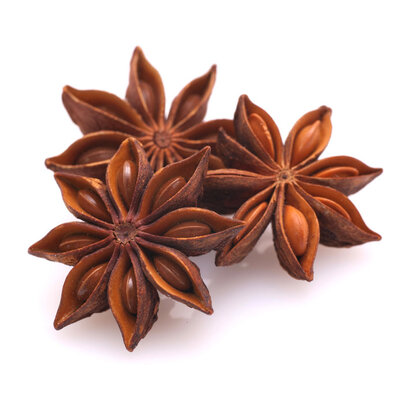
Star Anise
What is Star Anise?
Star anise is a spice obtained from the fruit of the Illicium verum evergreen tree. It gets its name from its shape, which is like a star with six to eight points. The spice is reddish brown in color and has a spicy and sweet taste. Aniseed comes from star anise, and its whole and ground forms are popularly used in cooking, including in the Chinese five spice blend.
- This spice is extensively used in Chinese, Indian, Malaysia, Indonesian, and Vietnamese cuisines, as well as in other countries of Indian subcontinent and South-East Asia.
- Also, it is commonly used in liquors and cocktails, as well as dishes such as rendang.
Some popular star anise brands on the market are:
- The Spice Way
- Spicy World
- Inspiration Industry NY
- Yamees
- Natural Plus Green
- Sanniti
- Burma Spice
- It’s Delish
- Powernutri
- Big Green
- Starwest Botanicals
Origin of star anise
This spice originated in China and Vietnam and has been used in these cuisines for more than 3,000 years. It was used medicinally and any pod with more than eight points was considered a symbol of good fortune. Later on, it made its way via the spice routes throughout Asia and Africa. English sailors brought it back to Europe in the 1500s. Currently, it is a spice that is used throughout the world.
Nutrition
Nutritional profile for star anise (100 pods / 20 g):

Star anise is used in the antiviral drug, Tamiflu, utilized for treating influenza. Apart from this, this spice also possesses antioxidant, antimicrobial, antifungal, anthelmintic, insecticidal, secretolytic, antinociceptive, anti-inflammatory, and gastroprotective properties. In addition, it may help in reducing the risk of cancers. Also, it may help in treating or reducing the risk of stomach aches, kidney dysfunction, vomiting, insomnia, skin inflammation, rheumatism, and bronchitis.
Commercial production
The largest producers of star anise in the world are China, Vietnam, India, Mexico, Turkey, and Egypt. The largest consumers are Asian countries, while the largest importers of this spice are the US and the EU. Growing star anise requires some sun and warmth, as it does not grow well in cold and windy climates. Loamy and well-drained soils with mild acidity are best for producing this spice. Additionally, it requires regular watering and pruning. The fruits are harvested when still unripe and green and then dried in the sun until they are reddish brown in color.
Star anise tecipes
This spice is an important component of several spice mixes including the Chinese five spice blend, Indian garam masala, Vietnamese pho, Moroccan ras el hanout, and Italian sambuca. It is used in making liqueurs, spiced wine, mulled wine, and cocktails. It is also a popular ingredient in some desserts, jams, and compotes. Overall, star anise is a versatile spice with multiple uses. Here are some recipes to try:
- Fish Curry
- Snickerdoodles
- Braised Chicken
- Massaman Curry
- Chicken Biryani
- Ayam Masak Merah
- Ketjap Manis
- Rosquillas de Anis
- Arroz con Leche
- Pear Clafouti
- Moroccan Coffee
- Anise Biscotti
- Sfouf
- Spiced Rice
- Amritsari Chole
FDA regulations
The FDA classifies star anise as a spice, which is defined as any aromatic vegetable substance in whole, broken, or ground form, whose function in food is seasoning rather than nutritional. Oil or other flavorings must not be removed from the product before being sold. It falls under the generally recognized as safe category as well.
References
Kanika Dhamija, Beginners Guide to Grow ‘Sweet & Spicy’ Star Anise, Krishi Jagran, https://krishijagran.com/agripedia/beginners-guide-to-grow-sweet-spicy-star-anise/
Patra, Jayanta Kumar et al. “Star anise (Illicium verum): Chemical compounds, antiviral properties, and clinical relevance.” Phytotherapy research : PTR vol. 34,6 (2020): 1248-1267. doi:10.1002/ptr.6614, https://pubmed.ncbi.nlm.nih.gov/31997473/
Tsui, Pi-Fen et al. “Spices and Atherosclerosis.” Nutrients vol. 10,11 1724. 10 Nov. 2018, doi:10.3390/nu10111724, https://www.ncbi.nlm.nih.gov/pmc/articles/PMC6266658/
